PRE2017 1 Groep2: Difference between revisions
| Line 124: | Line 124: | ||
Cyclists want to be surrounded by light, too, without changes in light that are too sudden, so their basic needs are regarded as the same as that of a pedestrian. However, when a car is coming towards a cyclist, the cyclist is looking into the headlights of the car. It is important in this situation that the cyclist is not blinded by the lights of the car and the driver of the car sees the cyclist clearly. This is because the cyclist and driver have to pass each other safely on the street. In the article ‘The effects of dimmable road lighting: A comparison of measured and perceived visibility’<ref>Chenani, Maksimainen. | Cyclists want to be surrounded by light, too, without changes in light that are too sudden, so their basic needs are regarded as the same as that of a pedestrian. However, when a car is coming towards a cyclist, the cyclist is looking into the headlights of the car. It is important in this situation that the cyclist is not blinded by the lights of the car and the driver of the car sees the cyclist clearly. This is because the cyclist and driver have to pass each other safely on the street. In the article ‘The effects of dimmable road lighting: A comparison of measured and perceived visibility’<ref>Chenani, Maksimainen. | ||
[http://www.sciencedirect.com/science/article/pii/S1369847816304193 "The effects of dimmable road lighting: A comparison of measured and perceived visibility"]</ref> it is stated that the visibility is not much dependent on the amount of light but mostly on the contrast. This means that if the light is coming towards them, the brightness of the streetlight has to be higher than when a car is heading in the same direction, to have a good visibility Therefore the streetlights should shine brighter in the preference of the cyclist. This is not something that has to be accounted for in the pedestrian's case, since the pedestrian is on not on the same road as the rest of traffic and likely will not be blinded by headlights. | [http://www.sciencedirect.com/science/article/pii/S1369847816304193 "The effects of dimmable road lighting: A comparison of measured and perceived visibility"]</ref> it is stated that the visibility is not much dependent on the amount of light but mostly on the contrast. This means that if the light is coming towards them, the brightness of the streetlight has to be higher than when a car is heading in the same direction, to have a good visibility. Therefore the streetlights should shine brighter in the preference of the cyclist. This is not something that has to be accounted for in the pedestrian's case, since the pedestrian is on not on the same road as the rest of traffic and likely will not be blinded by headlights. | ||
===Motorists=== | ===Motorists=== | ||
Revision as of 13:12, 30 October 2017
Group members
- Simon Kok (0850085)
- Xueyuan Chen (0961799)
- Lennart Heijnen (0957658)
- Lisanne Grevinga (0946763)
Project definition
The current street lights are based on a system that is extremely outdated. It is possible to reduce energy consumption by large quantities by changing the entire system. This will not only be good for the environment, but it can also reduce costs over time. By creating a SMART light plan, this all is possible while increasing safety and decreasing light pollution. As numerous studies have shown, different lighting conditions influence people greatly. By interpreting the results of those studies, a design will be made. The hypothetical design will be made for the residential area Meerhoven.
Objective
The different stakeholders have different objectives.
- Users: This are the people driving, walking, cycling, etc. past the streetlights. Their first priority is safety and visibility.
- Society: The society can be divided in two groups. First there is the people living in the area. Second is the municipality. For these stakeholders, it is important that it is cheap (in the long term). Other wishes could be the mood set by the lighting.
- Entrepreneurs: This are the people designing and making the SMART streetlights. For the companies, the most important is that they can make profit from the SMART streetlights.
In this project, most prominently the needs of users and society will be looked at. The objective is to design a dynamic lighting system that:
- Reduces energy consumption and light pollution
- Does not decrease safety
- Connects to user needs
- Is economically viable.
Approach
The approach for this project is to start with literature study, to understand the influence of street lights on the objectives of the stakeholders. This research should also contain the monitoring of crowds. Other than the literature study, stakeholders can be further investigated by speaking with the municipality and with researchers of the TU/e lighting group. With the results of these studies, the design requirements can be made. With these requirements and more study into the technical aspects, a design can be made. Finally a prototype will be build in the form of software.
Research
The first research done is in the form of literature study.
Articles
- Research at the TU/e has shown that pedestrians feel safer when their direct surrounding is lit, in comparison when the areas further away are lit. This is applicable to both females and males. Furthermore, it is the result of both stationary and walking pedestrians.[1]
- Visibility is mostly influenced by contrast. This mostly is problematic when there is oncoming traffic. To have a similar visibility, road lighting should be brighter when there is oncoming traffic. [2]
- Switching off lights in areas in England and Wales did not result in increased crime rates. Even though this study took place in other countries, it does suggest that decreasing light levels in the Netherlands will not increase crime rates either. [3]
- Monitoring people is a sensitive subject. Generally people dislike being monitored, even when the data cannot trace back to the individuals being monitored. [4] Even though this example is using monitoring for commercial ends, it might still be important even when safety is the goal.
Case Studies
- In the city of Los Angeles, 140,000 conventional street lights have been replaced by LED lights. Over the span of a year, these lights consumed 63% less energy. This in addition to higher reliability, reduced operating costs by 40%. In addition, crime rates in the area went down by 10%, though the study doesn't mention how they tested the correlation. It also shows that the lifespan of LED street lights are much higher than that of conventional bulbs, but again, no sources are mentioned.[5]
- Analysis show that over a span of 20 years, approximately €780 per light can be saved by using a networked LED system. Initial investment costs are high, however, payback time is only 6 years.[6]
Projects in and around Eindhoven
There are different smart street lighting project in the Netherlands. For example, there is a project at Stratumseind in Eindhoven and one at the Goorloopweg in Helmond. These streets are very different from each other. Stratumseind is a big street in Eindhoven with a lot of bars in it. During the night there are a lot of people and most of these people have had some alcoholic drinks, causing a higher risk of aggression on the street. The project at Stratumseind uses lights to make people less aggressive, by using different colors, brightness and light patterns. [7]. Then the Goorloopweg is a street in a sports park. During the nights it is quiet, mostly deserted and dark, although there are occasional pedestrians, jogging or walking their dog, for example. The streetlights on the Goorloopweg they try to create a safe place for people during the night using sensors. When someone walks by a streetlight, it will shine brighter than when no one is around.
Contacting the TU/e Intelligent Lighting Institute
An email has been sent to Antal Haans of the Intelligent Lighting Institute (ILI). Mr. Haans is an expert on lighting and social safety and one of the co-authors of the article Light distribution in dynamic street lighting: Two experimental studies on its effects on perceived safety, prospect, concealment, and escape, which is mentioned above. Additionally, he has worked on experiments with smart lighting systems at Stratumseind and in the Markthal at the TU/e. We aim to interview Mr. Haans on his work on the subject and his findings, so that we can get a better understanding of the needs of the users for a smart streetlight system.
Interview with Antal Haans
Haans worked on a smart street lighting project in a street in the Achtse Barrier in Eindhoven with the goal of saving energy without reducing the sense of safety. As a psychologist he and his team had to think of how such a street lighting system should work. 50 year old lights were replaced by LEDs and infrared sensors were installed. In order to come up with a lighting procedure, he did a research on the TU/e which showed that people prefer having their immediate surroundings illuminated as opposed to places further ahead in the street. Lithuanian professor Zukauskas did similar research and even suggests light in the distance is not needed at all. When a sensor detects a person, the light corresponding to that sensor switches on (from 10%, the base level, to 100%), as well as two lights to the left and right to that light. The lights go from 10% to 100% instantaneously. The lights then remain at 100% for a minute, mostly for practical purposes while conducting the experiment. After that time, the light would go back to 10% very slowly.
Results: users
Most people participating in this trial felt that the dynamic lighting had added value. First of all, they liked the idea of participating in saving energy. Secondly, they thought the lights switching on for them was welcoming.
There also were some unexpected results: a small number of people living in the streets started looking outside when they noticed lights switching on to see who was there, and they reported that there were a lot of false positives: lights switching on when there was nobody there. This was mostly because two lights next to the light sensing motion would also turn on. A few of the residents became a bit paranoid/anxious because of this. The main problem here is that the residents didn’t have a good mental model of the system: they didn’t know well enough how it worked. When implementing such a system, it should be made sure that the users develop a better mental model. Also, some people were bothered by the suddenness of the lights switching on.
A lot of people actually thought that the basic level of illumination (when no motion is detected) was enough. This could in part be explained because the previous, old lighting was very poor in terms uniformity and horizontal and vertical illuminance and the LEDs were a big upgrade from this. But it does suggest the dynamic system might not be very necessary. On the other hand, the people saying this of course didn’t walk through the street with just the low light level.
During the trial, Haans and his team came to realize cars don't need street lighting in this kind of neighborhood, meaning the lights could switch on gradually instead of instantaneously (the latter having been chosen with cars in mind).
Results: Energy saving
It was found that while a lot of energy was saved by switching to LEDs, very little additional energy was saved by implementing the dynamic lighting system: about 6€ worth of energy per light per year, which doesn’t make it economically viable, taken into account the costs of installing the wireless communication. Therefore, the system should be simplified. One option is to not use communication: a light simply goes on when it senses a person, without other lights reacting. In Tilburg there is an experiment on this.
Haans did explain that reducing light pollution nowadays has replaced energy saving as the driving force behind the development of dynamic street lighting. He did advise us to go speak with Richard Verhoeven, the researcher who handled the results of this trial in terms of saving energy. Verhoeven has been contacted.
What's left to explore?
According to Haans, one main issue that's important for creating dynamic street lighting is determining the area that should be illuminated for a pedestrian. The complexity of the system depends on this: the amount of lights that should switch on, and thus the amount of communication.
Additionally, while there is some research available about pedestrians, very little is known about interactions with others, especially other street users.
Interview with Richard Verhoeven
Verhoeven also worked on the dynamic lighting project in the Achtse Barrier. Two difficult aspects of the project were that Philips provided the hardware, so the team couldn’t directly make changes to it; and they had to comply with the government regulations for street lighting levels.
Dynamic lighting has to be cost-effective. However, the energy saving in the project only amounted to up to 5 euros per pole per year, so the number of ways to make this cost-effective is limited. The main issue is that the sensors themselves are expensive, so omitting the network wouldn’t cut the costs that much by itself. Infrared seems to be the cheapest, and reliable, but is still expensive; the one used in the project cost 150 euros, so this could never be cost-effective. The total cost of the sensors needs to go down.
Data from the internet about the weather conditions were collected. The effects of weather conditions on the wireless communication system were tested, but the results of this are not available, since there is no funding anymore. The infrared motion sensor that was used can be tuned for different regions. The output is binary, simply whether something is detected or not. When the sensor detects movement for a certain period of time, for example 100 ms, it sends a signal to all light poles in the vicinity, including the light pole that it’s attached to. If there’s still movement after 10 seconds, the signal is repeated. A few computers in the area collected all the data. The range of the sensor can be between 2 and 16 meters. One issue with the sensors is that when walking towards it, it doesn’t detect as much movement, so the range is limited.
Without a network, sensor ranges should be sufficiently large. In addition, problems could arise since sensors can’t detect what’s around a corner. There have been ideas about lights being activated not by a motion sensor, but by smartphones. But obviously, any such idea would exclude people. Another idea is to only install sensors at entry and exit points in the street and let the whole area light up when something is detected there. But this would be problematic, because people could leave their house in the middle of the street and nothing would be detected. Also, if people stop or walk slower than expected, the light will turn off at some point.
Current regulations provide minimum light levels (about 5 lux for busy roads, 2-3 lux for residential streets) and also consider the distribution of the light (no dark spots), but if it can be guaranteed that there is no activity at a certain place, it’s allowed to go below this. But there should always be some minimum light. The energy saving compared to non-dynamic LED was about 35%. Since LED doesn’t use a lot of energy anyway, this saving is very small in absolute numbers. One way to make the system more cost effective would be to integrate other sensors into the system, for example to measure pollutions and other environmental factors that might be interesting. This way the network is multi-purpose and more interesting to invest in. Also, a more promising way of dynamic lighting might be to use sensors to make an activity profile of a neighborhood, and base the light levels at different times in the night on this.
Verhoeven suggests that we should take errors into account to test how well our system behaves. For example, what if a signal from a sensor is somehow lost? What if one of the lights breaks down?
Scenarios
In the project, a street in the suburb of Meerhoven has been chosen. Firstly, because it is a big street where cars come from both directions. Secondly, there is not a lot of work traffic, but only traffic from the people that live in Meerhoven. In this chapter first a description of the street will be given, then the preferences of the users are given and then an example for different scenarios will be given.
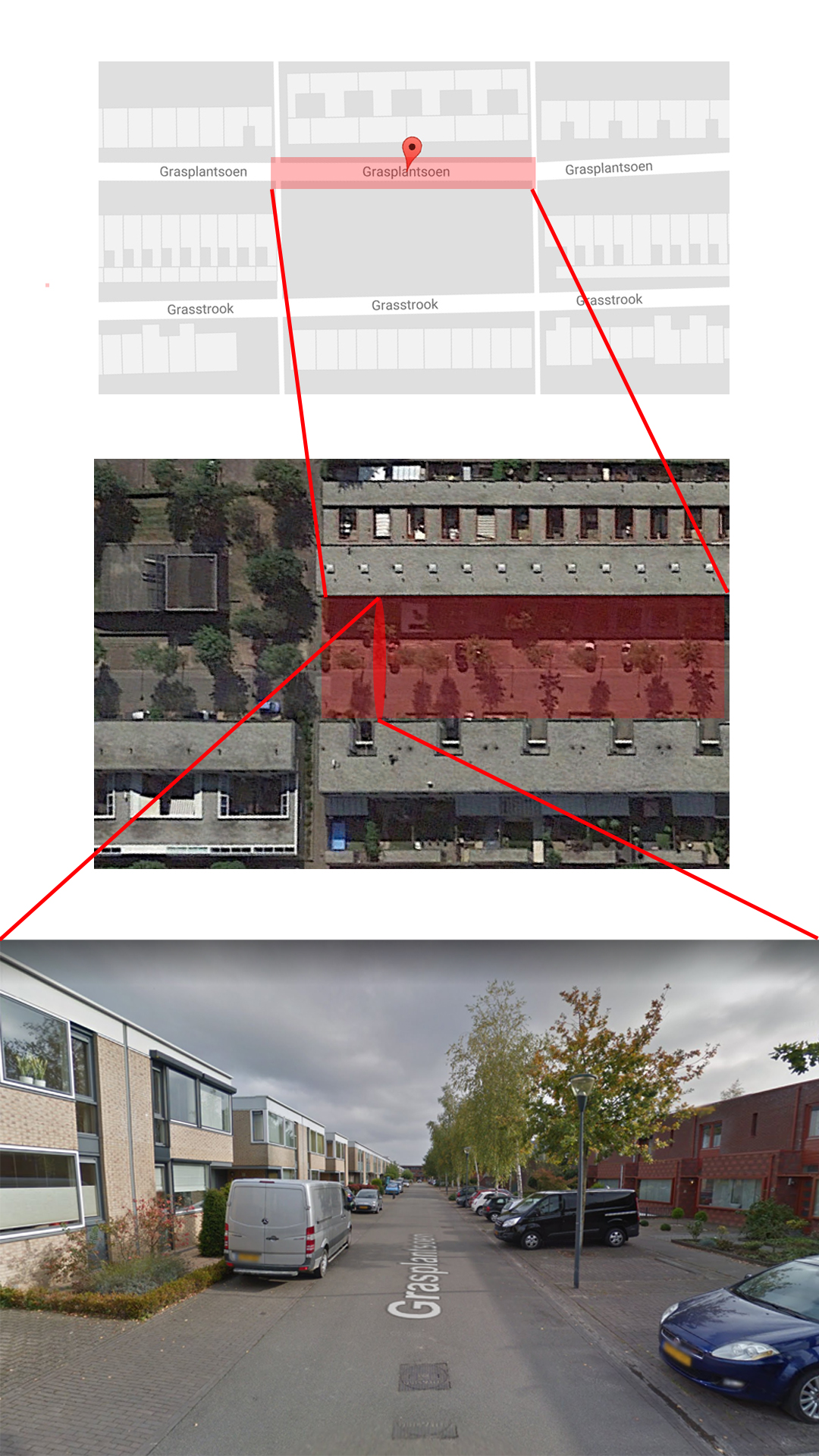
Street Description
The model street that is used is presented in figure 1. The street consists of a two-way road for cars and bicycles on one side of the street, a sidewalk on the other side, and in between are parking spaces with street lights in between them. The street lights are placed 15 meters apart. There are houses on both sides of the street. There are no intersections on the part of the street we are designing for.
The users and their needs
There are three kinds of road users that are taken into account:
- Pedestrians
- Cyclists
- Motorists
For now, the preference of the pedestrian and the cyclist are the same. However the cyclist is faster then a pedestrian and that is why the system should react differently if a cyclist is passing by.
Additionally, the needs of the residents should not be forgotten.
Pedestrians
Haans and de Kort's[8] research about the preferences of a pedestrian walking on the street showed that people feel safer when they are surrounded by light rather than that having light in front of them, further down the street. So most importantly, the streetlights around the pedestrian/cyclist should be turned on and the one that is the closest to the pedestrian/cyclist should shine the brightest. The lights should not turn on and off too quickly, because this might disorient the pedestrian.
Cyclists
Cyclists want to be surrounded by light, too, without changes in light that are too sudden, so their basic needs are regarded as the same as that of a pedestrian. However, when a car is coming towards a cyclist, the cyclist is looking into the headlights of the car. It is important in this situation that the cyclist is not blinded by the lights of the car and the driver of the car sees the cyclist clearly. This is because the cyclist and driver have to pass each other safely on the street. In the article ‘The effects of dimmable road lighting: A comparison of measured and perceived visibility’[9] it is stated that the visibility is not much dependent on the amount of light but mostly on the contrast. This means that if the light is coming towards them, the brightness of the streetlight has to be higher than when a car is heading in the same direction, to have a good visibility. Therefore the streetlights should shine brighter in the preference of the cyclist. This is not something that has to be accounted for in the pedestrian's case, since the pedestrian is on not on the same road as the rest of traffic and likely will not be blinded by headlights.
Motorists
For the drivers, the most important thing is that they can see if there is other traffic coming so they can give priority to traffic that is coming from the right and they can just simply stop in time. As stated in the description of the street the cars are allowed to drive 30 [km/h]. This means that they have a stop distance of 5,3 meters including response time [10]. So at the bare minimum, the driver has to see around 10 meters ahead. The average distance a light of a car can light up is 60 meter, in front of the car, with a low beam [11]. This means that the car's headlights are good enough to see the cyclist on time and the driver does not need the streetlights to be on. So the dynamic street lights should not respond when just a car is driving on the street.
Residents
The residents need to feel safe in their own neighbourhood. To ensure this, the lights should never be completely turned off; there should always be a minimum of light in the street.
Designing the systems
Because of the potentially limited economic viability of a complex dynamic lighting system, it was decided to design two systems: one system operating without a network, limiting the investment costs to just the motion sensors, and one system using a network, more expensive but possibly worthwile due to increased connection with the needs of the users.
Design of the non-network system
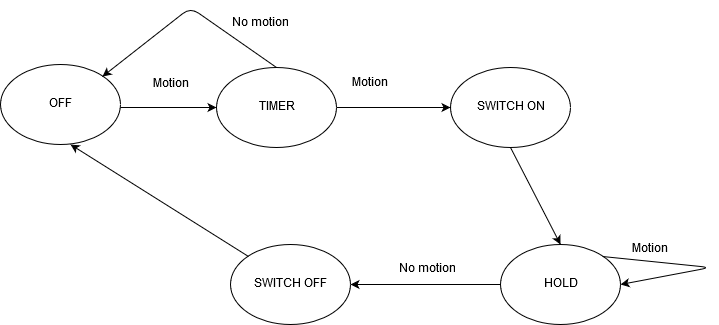
In this system, every light works independently, using its own passive-infrared sensor to sense motion and act accordingly. The decision-making that this system uses is shown in figure 2.
The streetlight's initial state is 'off'. This does not mean the streetlight is completely turned off, however; in accordance with the needs of the residents, the light is shining at 10% of its total capacity in its initial state, when no motion is detected. When the sensor belonging to that streetlight senses motion, a timer is started. If at the end of this timer, no motion is detected, the system remains at the initial state. The timer needs to be sufficiently long to let a car pass, since motorists have no use for the light to go on. If there is still motion at the end of the timer, this means a slower user such as a cyclist or pedestrian is approaching, so the light goes to the state 'switch on'. In this state, the streetlight increases its illuminance with a fixed amount per second, for example 5% of total capacity per second, until a limit, for example 40% of total capacity, is reached, at which point there is a transition to the 'hold' state. In this state the light simply keeps its illuminance constant for a fixed amount of time, for example 15 seconds; enough to let the road user pass. If the user is still within range and motion is sensed after this time, the streetlight will simply 'hold' again; if not, it will go to the state 'switch off', gradually decreasing its illuminance until it is at 10% again.
UPPAAL model
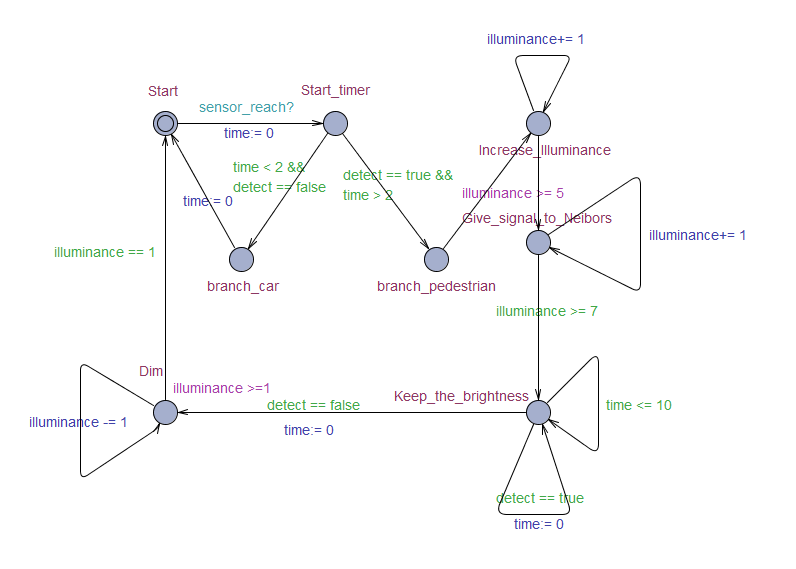
The prototype of this model is built up using UPPAAL [12] which is an integrated tool environment for modeling, simulation and verification of real-time systems, developed jointly by Basic Research in Computer Science at Aalborg University in Denmark and the Department of Information Technology at Uppsala University in Sweden. In figure 3, the left part is of the light controller for each independent street light pole and the right part is the model of the sensor. The sensor model simply has two states of which "idle" represents nothing is being detected and the other "within_range" means it detects some object being in its range. It also keeps updating a global Boolean variable "detect" to store the status of the detecting. When the sensor detects something it sends the signal "sensor_reach!" through the channel to the controller. Then the controller starts the timer to determine the exact object type of the object. If the object moves fast and the sensor loses its focus in 2 seconds, the controller remains the minimum brightness of the lights. If after 2 seconds the sensor still focuses the controller determines the object is a pedestrian and start to bright up. After the illuminance reaches 50 percent of the maximum it can send signal to its neighbors and continues to bright up. After it gets to 70 percent the controller keeps the brightness for 10 seconds. Then if the sensor still detects an object within its range, the timer resets and count another 10 seconds. Otherwise it will lessen the brightness gradually to the minimum.
Design of the network system
To improve the performance of the whole system, all light poles are connected as a network. In the network system, it is useful to detect whether the sensed object is a car, a cyclist or a pedestrian. It was found that through using a active infrared sensor with software, this can be done reliably.[13] One such sensor is added to each end of the street. With the two infrared rays from the sensor the system can detect, with a 90% reliability, whether a car, cyclist or pedestrian is passing by. Besides those two extra sensors, the motion sensors are deployed as before on each light pole. An overview of the street can been seen in figure 4. In this figure the red lines are the two infrared rays that can detect the different between a car or cyclist and the circles around the streetlights (yellow dots) indicates the sensing range of the motion sensors.

For the network system, first the system has to detect which 'subsystem' should run. There are four different subsystems:
- Nothing: when for example only a car is passing by the system should not react and the streetlights should not illuminate.
- Pedestrian: when a pedestrian is walking by the streetlights, the lights should illuminate to 40% of total capacity.
- Cyclist: when a cyclist is passing by the streetlights should illuminate to 40% , but quicker than in the pedestrian's case.
- Opposites: when a car and a cyclist approach from different sides, the streetlights should illuminate to 60%.
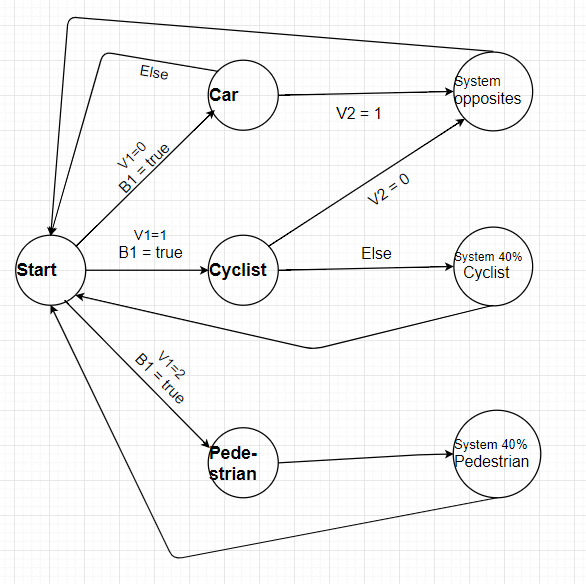
First, a higher-level system has to be designed to determine which of the four systems should be used. An overview of how the system works can be seen in figure 5. For this overview the sensor that detects movement (B) can either return true or false. When true it detects movement and when false is detects no movement. For the sensor that detects the difference between car, cyclist or pedestrian (V) it gives a different number for what it detects. With 0 being a car, 1 being a cyclist, 2 a pedestrian and 3 when it detects nothing.
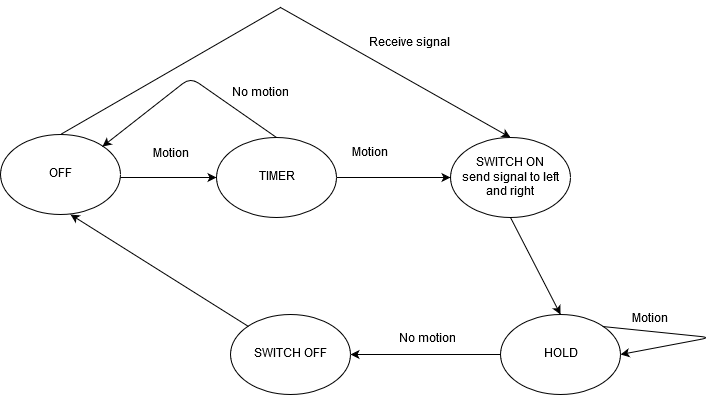
Except for the scenario in which nothing happens, the working of the lights is basically the same, and an extension of the non-network system, as shown in figure 6. Now, the timer is not there anymore to prevent the lights going on for cars; it only serves to prevent triggering of the system by, for example, cats or falling leaves, so the timer is shorter in this system. If motion is confirmed, the streetlight switches on in the usual way, with the addition that a few seconds after illuminating as much as it should, it also sends signals to the neighboring streetlights, which start illuminating after receiving the signal. When a streetlight senses motion itself, it sends such a signal to both neighbors, but when it activates through a signal from a neighbour, it only sends a signal to the other neighbor.
For different subsystems, the system parameters have different values. For example, in order to accomodate the pedestrian, assumed speed 1 m/s, it was initially chosen to let the light increase by 5% per second, send a signal to the neighboring lights 8 seconds after detection, keep the illuminance at 40%, and then decrease by 5% per second. In this way, with the poles being 15 m apart, the next light has reached 40% by the time the pedestrian reaches it.
For the cyclist however, assumed to go at a speed of 5.5 m/s, the streetlights should go from 10% to 40% in a second in order to keep light levels constant for the cyclist; so the value for the 'switch on' parameter should be 30% per second. Because the cyclist passes the lights faster, 'hold' only has to last 5 seconds. If a cyclist encounters a car, the 'opposites' subsystem should instead be used, meaning the lights will go to 60% instead of 40%.
UPPAAL model
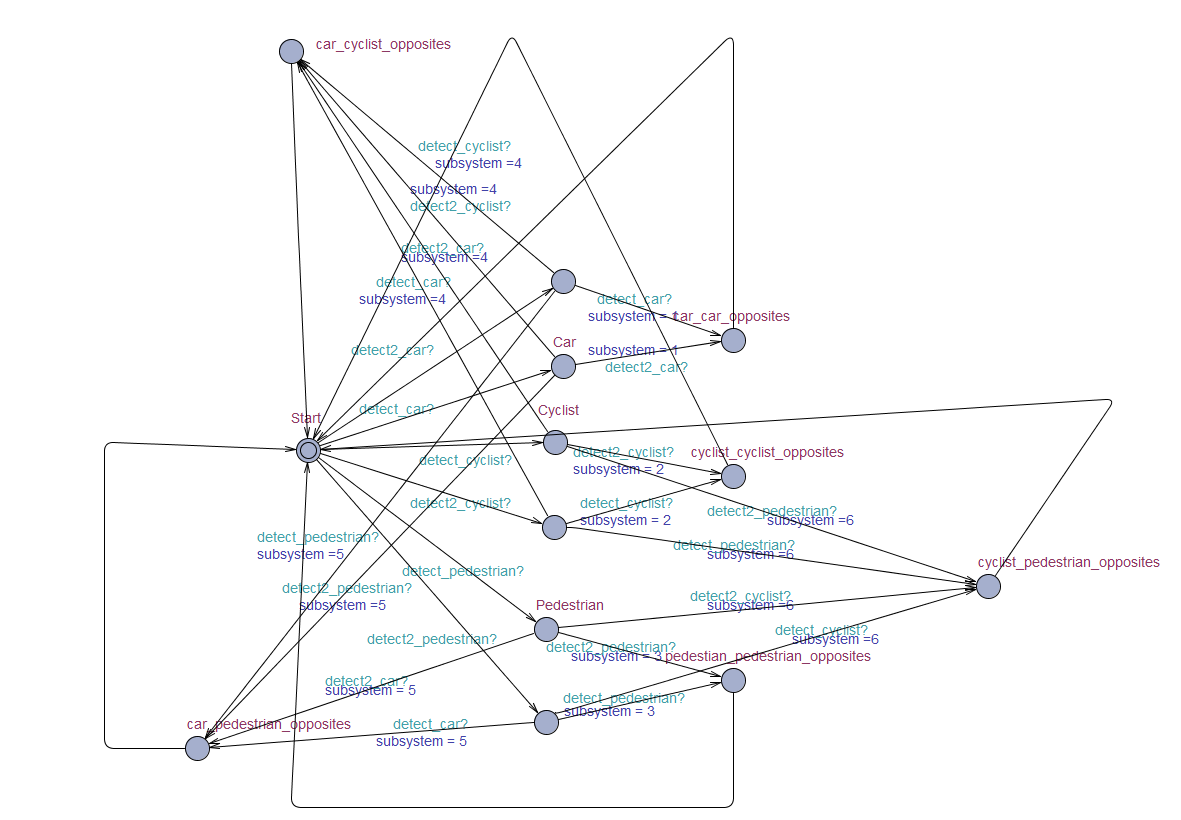
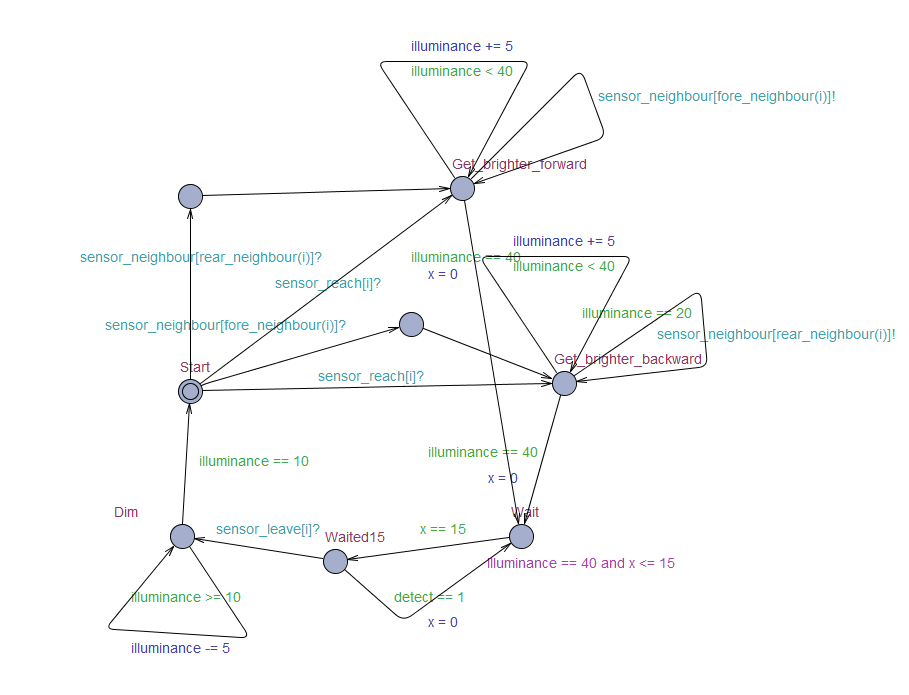
The network system modeled in UPPAAL is shown in figures 7, 8, 9 and 10. The network model contains 4 streetlights. Every streetlight has a motion sensor, and at the two entrances of the street there is an active infrared sensor that uses software to distinguishe between cars, cyclists and pedestrians. Depending on the types of traffic users detected, the appropriate subsystem is chosen by the "System" model. There are 6 subsystems which represent "car-car opposite scenario", "cyclist-cyclist opposite scenario", "pedestrian-pedestrian opposite scenario", "car-cyclist opposite scenario", "car-pedestrian opposite scenario" and "cyclist-pedestrian opposite scenario" respectively. The state transitioning to choose subsystems depends on the signals from the 2 type sensors. After a certain subsystem is chosen, the global variables will change accordingly in order to adapt the network system to the certain scenario.
The motion sensor modeled here is the same as that in the non-network model. As the type sensor detects the object in a short range within a short time, it is modeled simply by using one state with different self-loops updating the global variable that stores the type of the objective.
The behavior of the subsystems is shown in the "light" model. As an example, the subsystem that should be activated when only pedestrians are on the street is presented. There are three possible causes for streetlight i to be activated; either it senses motion (sensor_reach), it receives a signal from streetlight i-1 (sensor_neighbour[fore_neighbour(i)]), or it receives a signal from streetlight i+1 (sensor_neighbour[rear_neighbour(i)]). In all cases, the light starts to get brighter by 5 percent (of maximum illuminance) per second from its base illuminance of 10%, until it reaches 40%. At the point when it reaches 20%, it sends a signal to either light i+1 (if it was activated by a signal from i-1), to light i-1 (if it was activated by a signal from i+1) or to both (if it was activated by detecting motion). This is what the two states get_brighter_forward and get_brighter_backward are for: to get brighter and send a signal to the appropriate neighbors. Afterwards, it goes to state Wait in which the light stays at 40% for 15 seconds; if after this time, motion is still detected, it waits another 15 and so on; if not, it goes to state Dim, dimming by 5% per second until the base level of 10% is reached.


Simulation
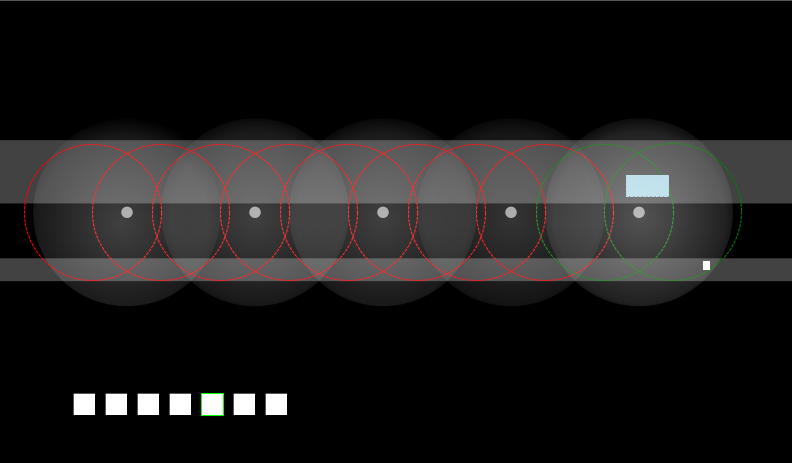
Two simulations have been made: one for the non-network system and one for the network system. In this chapter, a short explanation of the two models will be given. For both simulations, the program Eclipse is used with the program language CIF. With this program, an SVG file can be made to get a clear visualization of the script. For both the same SVG file is used, see figure 11.
In this figure the white dots are the streetlights, the dotted lines are the sensor. If the dotted line is green, the sensor is detecting something and if the dotted line is red, it is not detecting anything. The grey region on the bottom is the sidewalk and the grey region at the top is the road. On this road cars or cyclist use the same road and come from both directions. On the bottom left side, there are a number of buttons. These buttons can do different things for the non-network system en the network system.
For both the non-network system and the network system a calculation has been made of the visibility for the pedestrians. With this value, a conclusion can be made whether the new systems are decreasing the visibility of the users by using less light. More about the visibility can be found in the chapter Results.
Non-network system
For the non-network system, a pedestrian, cyclist or car can be added in the simulation by pressing one of the buttons. When one of the sensors is detecting something the streetlights should react, the sensor detects something when coordinates of the pedestrian/car are in the range over coordinates of the sensor, by starting a timer. The illumination should wait a view seconds before the lights illuminate, therefore the timer is there. This because any errors by the sensor are left out. After this, the streetlight starts illuminating until it is at its maximum level. In the non-network system cannot detect whether a car or pedestrian is passing by what means it always illuminates to the same level of illumination of 80%. After the sensor does not detect anything the streetlights stay on the same level of illumination for 15 seconds.
Network system
The network system has the same visualization as the non-network system but works a slightly differently. For the network system, some different use cases (scenarios) are introduced. With these different use cases, it can be shown that the system reacts differently to different situations. A brief explanation of these use cases can be found in the following table:
| Use case | Situation | Maximum illumination | Total seconds on after detecting |
| 1 | A car coming from the left | 20 percent | 10 seconds |
| 2 | A pedestrian coming from the left and after some time a car is coming from the right | 70 percent | 5 seconds |
| 3 | A pedestrian is coming from the left | 50 percent | 1 seconds |
| 4 | One pedestrian is coming from the left and one from the right | 50 percent | 1 seconds |
| 5 | A cyclist is coming from the left | 50 percent | 1 seconds |
| 6 | A car is coming from the left and a cyclist is coming from the right | 80 percent | 10 seconds |
When pressing one of the buttons, one of the use cases will start running. In the different use cases, the streetlights react differently. This is possible because this system can detect whether a car or a pedestrian is passing. This part of the simulation has not yet been written. What is also different in comparison with the non-network system is that the streetlights can communicate with each other. This means that when the streetlight is at a certain level, a signal to the next streetlight is sent. When a streetlight gets a signal it starts to illuminate. This ensures that the light surrounding the user remains constant.
Results
Recommendations
There is still a lot of that can be done in order to improve and expand the project.
- The number of scenarios that the systems and the simulation can handle should be greatly increased, preferably to the point that the design works for any combination of road users, from any direction, at any time. Also, intersections and bends could be added to make the design applicable to more situations. Additionally, influence of weather conditions could be researched in order to improve the lighting systems for more situations.
- The ‘visibility’ function as a measure of feeling of safety is quite crude, and could be made more representative.
- The simulation could be used to see what happens if the system fails in any way, for example, a light not working or a signal not getting sent. If the failure is not too major, the consequences for the road users should not be too big either.
- In the network system, the higher-level system (determining what behavior the lights should display based on the scenario) should be added to the simulation.
- More research is needed into the actual hardware and how the designs could be implemented.
Conclusion
Two systems for dynamic road lighting were designed in this project, one that works in a network and one that does not. Both systems fulfill the prime goal of reducing energy consumption and light pollution without reducing safety, as demonstrated by the simulations; there is less total illuminance, without decreasing the visibility of the road users. Although not all possible scenarios have been worked out, both systems generally seem to fulfill the user’s needs for safety and stability. The one without network is more likely to be economically viable, since it is just dependent on the sensor costs. Still, the network system has clear added value over the other one, with more energy saving and better adaptability to different scenarios.
In addition, a simulation was created that succeeds in visualizing and testing the designed systems, and could be used in the same way for any other system that could be designed. Even more, the simulation can be used for optimizing these systems and getting the best possible results. Also, for the most part the systems were recreated in UPPAAL, providing a valuable first step for any potential hardware implementation.
References
- ↑ Haans, de Kort."Light distribution in dynamic street lighting"
- ↑ Chenani, Maksimainen. "The effects of dimmable road lighting: A comparison of measured and perceived visibility"
- ↑ Perkins, Steinbach. "What is the effect of reduced street lighting on crime and road traffic injuries at night? A mixed-methods study"
- ↑ Verhagen. "U wordt gefilmd (en uw emoties gemeten): wat doen die camera's in billboards op stations?"
- ↑ SilverSpring. "A brighter future"
- ↑ SilverSpring. "Whitepaper The business case for smart street lights"
- ↑ Irene M. "Eindhovens news"
- ↑ Haans, de Kort."Light distribution in dynamic street lighting"
- ↑ Chenani, Maksimainen. "The effects of dimmable road lighting: A comparison of measured and perceived visibility"
- ↑ C] S. Plainis, I.J. Murray and G. Pallikaris, April 12th 2006, ‘Road traffic casualties: understanding the night-time death toll’, Retrieved on the 20th of September 2017.[1]
- ↑ C] Wikipedia, last added on 16th of September 2017, ‘Headlamp’, Retrieved on the 20th of September 2017 [2]
- ↑ Team of development of UPPAAL "Introduction to UPPAAL"
- ↑ http://citeseerx.ist.psu.edu/viewdoc/download?doi=10.1.1.562.8012&rep=rep1&type=pdf "DEVELOPMENT OF A BICYCLE AND PEDESTRIAN DETECTION AND CLASSIFICATION ALGORITHM FOR ACTIVE-INFRARED OVERHEAD VEHICLE IMAGING SENSORS"
- ↑ Varshney, Sun."Why do we perceive logarithmically?"